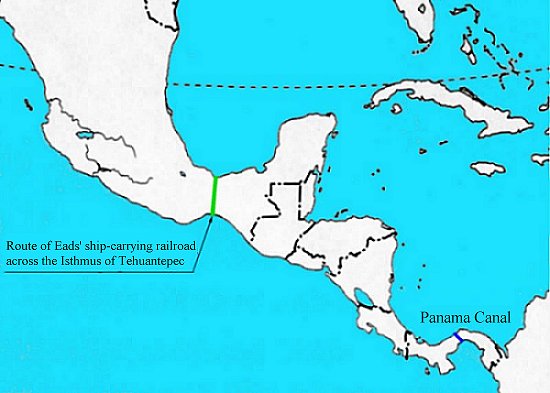An Un-Panama Canal
For a Spanish language version of this episode, Click Here.
Today, an Un-Panama Canal. The University of Houston's College of Engineering presents this series about the machines that make our civilization run, and the people whose ingenuity created them.
Next time you're near a map, look at the quirky geography of Central America. You'll notice that not one but two narrow necks of land separate the Atlantic from the Pacific. The Isthmus of Panama is fifty miles wide. Mexico's Isthmus of Tehuantepec, between the Gulf of Mexico and the Pacific, is 134 miles wide. By the way, the direction from the Atlantic across Panama is not westward, but southeast. From the Gulf across the Mexico strip is due south.
Mexico's Tehuantepec Isthmus is dry, while Panama is wet and muddy. Still, when it first came to moving freight from one ocean to the other, all eyes turned toward Panama. It looks so small on any map, and climate is not evident on maps.
It may come as a surprise that, as early as 1855, the U.S. had already built a railroad across Panama. That railway only hinted at the murderous cost of building a canal. Six thousand railroad workers died of cholera. Nearly five times that number of canal workers would ultimately die, primarily of yellow fever.
Writer Joseph Vollmar offers a remarkable note on our struggle to get ships across the continent. In 1879, Paris held a congress on linking the oceans. It would be the incubator for Ferdinand de Lesseps' abortive attempt to build a Panama Canal in the 1880s. The U.S. finally finished the canal 35 years after the Paris meeting.
When the American engineer James Eads heard about the Paris congress, he reacted. Eads was no stranger to engineering on an epic scale. After the Civil War, he'd built the St. Louis Bridge across the Mississippi, with the longest steel arches ever made. During the War he'd built many of the Union's big ironclad gunboats. He was to America what de Lesseps was to France.
He knew how hard it would be to build a system of locks across Panama. Instead, he proposed a rail system for moving ships overland, across the Isthmus of Tehuantepec. He planned to slide a 350-foot flat bed under ships in a 450-foot dry dock. Three double locomotives abreast would pull the ships onto dry land and across Mexico on three parallel sets of railroad track. Adjustable rams on the flat bed would form a cradle, unique to each ship's hull.
Eades went to Congress with his plan. In 1887 he learned that the Senate had approved his idea. He died a few months later, without ever knowing that the House of Representatives subsequently blocked it. Eads had argued that the cost of his plan would be only half the cost of either building or maintaining a canal; most ocean trips would be two thousand miles shorter; and on rail, ships would cross land twice as rapidly as in a canal.
America and France ultimately paid a terrible price for the canal, in both money and human life. The history of engineering is filled with tantalizing what-ifs. But few are so filled with possibility as the image of Eads' ships moving with stately grace, by rail, across Mexico.
I'm John Lienhard, at the University of Houston, where we're interested in the way inventive minds work.
(Theme music)
J. E. Vollmar, Jr., The Most Gigantic Railroad. Invention and Technology, Vol. 18, No. 4., Spring 2003, pg. 64.
